![]() IDEAS
IDEAS
![]() Tweet
Tweet
 Vacation
Rentals
Vacation
Rentals
![]()
|
Made With |
|
|
|
|
Dr. Hoffer's Travel WebSite This site was last updated 02/10/13 |
Flag of Lyon
Monday, July 25, 2005
Since Lyon is the second largest city in France, it deserves a
 little
more history
little
more history
 of
this vibrant city of the Lion (crest left.) Let me discuss in more detail the
important sections of Lyon. First, the city is divided into 9
arrondissements
(right.) An arrondissement is an administrative division in France but
only Paris, Marseilles and Lyon have municipal arrondissements.
of
this vibrant city of the Lion (crest left.) Let me discuss in more detail the
important sections of Lyon. First, the city is divided into 9
arrondissements
(right.) An arrondissement is an administrative division in France but
only Paris, Marseilles and Lyon have municipal arrondissements.
Our hotel is in the area called
Le Part-Dieu
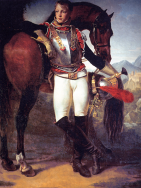 on
the east bank of the Rh�ne River, in the 3rd arrondissement (No. 3 right.)
Below left is a night shot of the area we are staying in. Below right is a
monument to the French cuirassiers located here.
Cuirassiers were mounted
cavalry soldiers equipped with armor and firearms (above left 1810,) first
appearing in late 15th-Century Europe. They were the successors of the
medieval armored knights. This French term means "the one with a cuirass"
(cuirasse), the breastplate armor which they wore.
on
the east bank of the Rh�ne River, in the 3rd arrondissement (No. 3 right.)
Below left is a night shot of the area we are staying in. Below right is a
monument to the French cuirassiers located here.
Cuirassiers were mounted
cavalry soldiers equipped with armor and firearms (above left 1810,) first
appearing in late 15th-Century Europe. They were the successors of the
medieval armored knights. This French term means "the one with a cuirass"
(cuirasse), the breastplate armor which they wore.
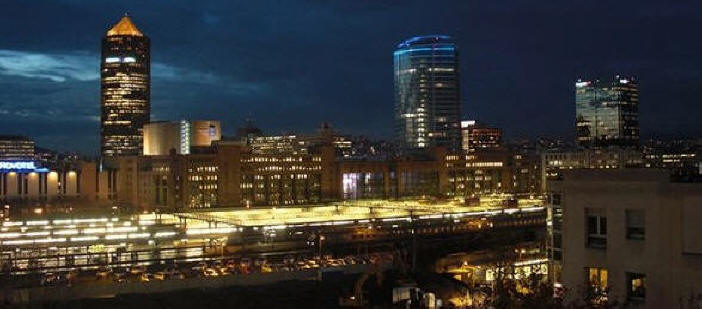
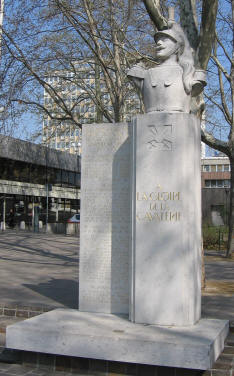
Le Part-Dieu is the second most important area of the city after Presqu'�le. It is also the 2nd-largest business district in France after La D�fense in Paris. It is a major transport and commercial gateway for Europe and has one of the largest shopping malls in Europe.
Presqu'ile (literally the "peninsula") is the land between the Rh�ne and Sa�ne Rivers just north of their confluence and contains 3 arrondessements (see Nos. 1,2,4 above right.) Below is an 1863 plot map of Presqu'ile.
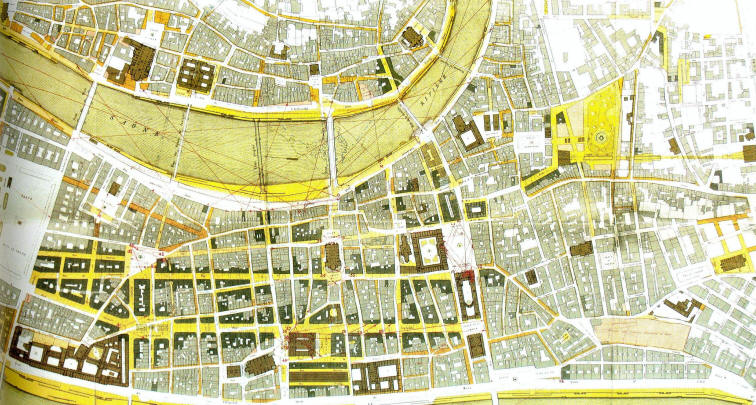
Here are maps of the 1st arrondissement (below left) and the 2nd arrondissement (below right.)
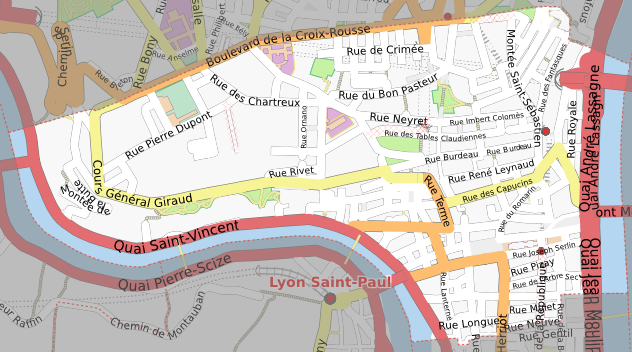
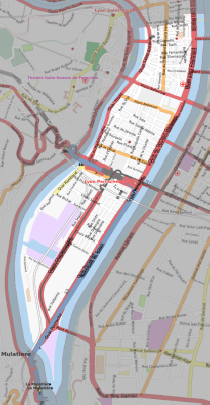
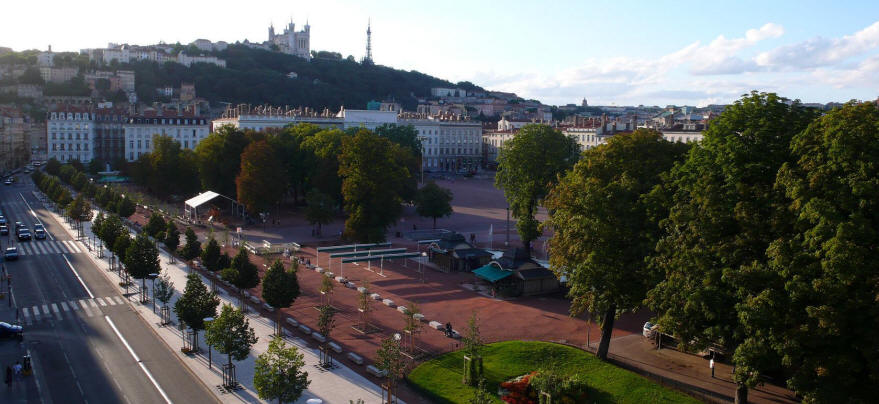
Above, Place Bellecour is the defined "center of Lyon;" all distances are measured from this point. Encompassing an area of 667,362 ft� (62,000 m�,) it is the largest clear non-traffic square in Europe. Below is a stock panorama of the square. You can see in the center of the square, the equestrian statue of Louis XIV I showed yesterday (see Diario #36.)
.jpg)
There is a large Ferris wheel in Place Bellecour (stock photo below) but I never saw it.
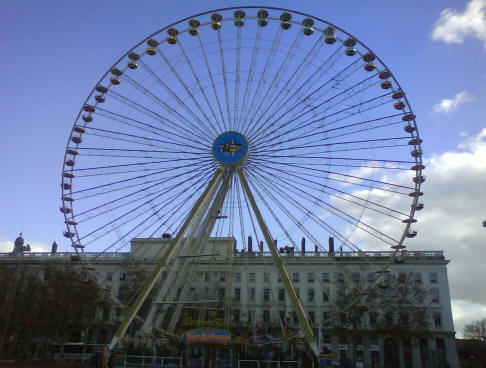
Rue de la R�publique is the main shopping street of the city. The street is over a kilometer in length and follows a north-east axis from Place Bellecour to the Place de la R�publique, then a north south axis to the Place Louis Pradel (see below.) The stree has stores of all types, two kiosks, a glass carousel, two large plane trees, benches and in the middle of the square, there is a large rectangular pool with many water jets (see later.)

North of there is the area they call
La Croix-Rousse
(above.) It means "The russet cross" because of the cross the Christians
put there i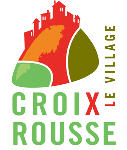 n the 1500s: made of stone taken from
Couzon-au-Mont-d'Or, which was
reddish-brown. It is a hill (833 ft (254 m) at its peak) as well as the
name of a quarter located on this hill. It is divided into two halves; the
"pentes," which is the part located in the 1st arrondissement, and the
"plateau," in the 4th arrondissement. It is near the Place des Terreaux.
The quarter is heavily involved in the silk industry. At one time Lyon was
the center of silk manufacture in Europe. Here
is Maison des Canuts [
n the 1500s: made of stone taken from
Couzon-au-Mont-d'Or, which was
reddish-brown. It is a hill (833 ft (254 m) at its peak) as well as the
name of a quarter located on this hill. It is divided into two halves; the
"pentes," which is the part located in the 1st arrondissement, and the
"plateau," in the 4th arrondissement. It is near the Place des Terreaux.
The quarter is heavily involved in the silk industry. At one time Lyon was
the center of silk manufacture in Europe. Here
is Maison des Canuts [ 10 Rue d'Ivry,
10 Rue d'Ivry,
![]() +33-47-828-6204, closed Sun] the Museum of Silk where you can see the history of
silk looms. Between 1831 and 1848, the canuts (Lyonnaise fabric weavers)
revolt
+33-47-828-6204, closed Sun] the Museum of Silk where you can see the history of
silk looms. Between 1831 and 1848, the canuts (Lyonnaise fabric weavers)
revolt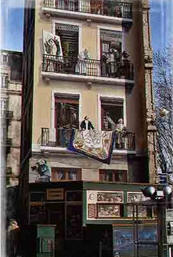 ed
to improve their living and working conditions. In following the evolution
of weaving techniques, this museum traces the history and evolution of what has
become a Lyonnaise symbol. The exhibition covers the evolution of weaving
technique and, of course, the technique of making Jacquard, which allowed them
to produce five times more per day. The shop offers a vast selection of
squares, scarves, neckerchiefs, ties, 100% natural silk articles�all made in the
pure canut tradition. Admission is �3. Also this is where the Roman historic Amphitheatre des Trois Gaulles
is located that was built in 19 AD. I've got to see this tomorrow.
ed
to improve their living and working conditions. In following the evolution
of weaving techniques, this museum traces the history and evolution of what has
become a Lyonnaise symbol. The exhibition covers the evolution of weaving
technique and, of course, the technique of making Jacquard, which allowed them
to produce five times more per day. The shop offers a vast selection of
squares, scarves, neckerchiefs, ties, 100% natural silk articles�all made in the
pure canut tradition. Admission is �3. Also this is where the Roman historic Amphitheatre des Trois Gaulles
is located that was built in 19 AD. I've got to see this tomorrow.
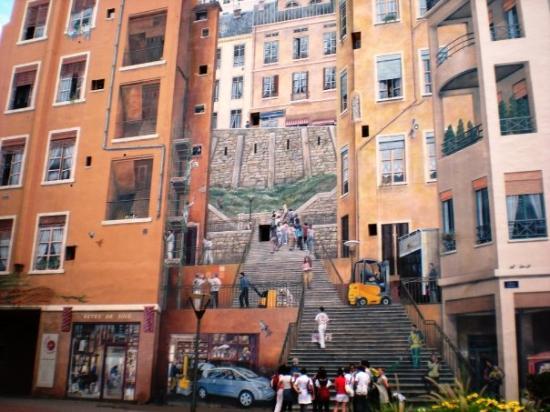

The �glise St-Polycarpe (St. Polycarp Church) [Rue Ren� Leynaud] appears
suddenly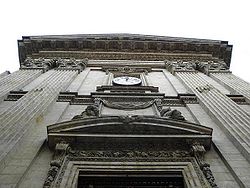
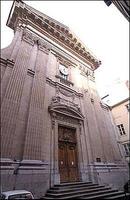 between the buildings of the Croix Rousse neighborhood. It was built as an
abbey church for Oratorian monks in 1670 and was dedicated to St. Polycarpe who
was an early Christian leader who knew the Apostle John and taught St. Ireneaus
of Lyon. The church's facade was added by Toussaint Loyer in 1756.
In 1791, it became a parish church and it was damaged during the French
Revolution: you can still see the cannonball marks.
between the buildings of the Croix Rousse neighborhood. It was built as an
abbey church for Oratorian monks in 1670 and was dedicated to St. Polycarpe who
was an early Christian leader who knew the Apostle John and taught St. Ireneaus
of Lyon. The church's facade was added by Toussaint Loyer in 1756.
In 1791, it became a parish church and it was damaged during the French
Revolution: you can still see the cannonball marks.
Below is a stock photo of the
Palais de la
Bourse [20 Place de la Bourse,
![]() +33-47-240-5858] (Palace of Commerce) which houses the Lyon Chamber of Commerce.
+33-47-240-5858] (Palace of Commerce) which houses the Lyon Chamber of Commerce.

The building was inaugurated by Napoleon III in 1860. On June 24, 1894, French President Sadi Carnot (below left) was assassinated by an anarchist named Caserio while he was leaving the building under the windows on rue de la R�publique. There is a marble plaque (below right) on the building memorializing the event.

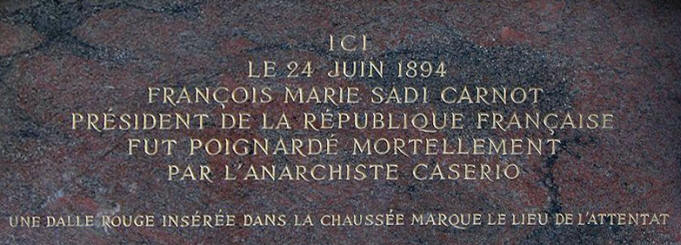
Historically, the Celts started this town in ancient times and it was dedicated to
Lug (or Lugh,) the Celtic god who ruled over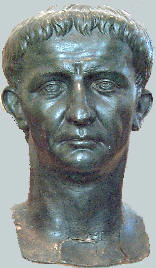
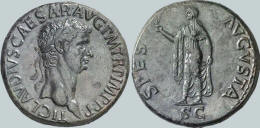 the rising of the sun.
Romans thought of him as their god of Mercury and created the city of Lugdunum in 43 BC. The Roman Emperor
Claudius (right) was born here
in Lyon in 10 BC. His maternal grandparents were
Mark Antony and
Octavia Minor
(Caesar Augustus' sister) and as such he was the great-great grandnephew of
Gaius Julius Caesar.
the rising of the sun.
Romans thought of him as their god of Mercury and created the city of Lugdunum in 43 BC. The Roman Emperor
Claudius (right) was born here
in Lyon in 10 BC. His maternal grandparents were
Mark Antony and
Octavia Minor
(Caesar Augustus' sister) and as such he was the great-great grandnephew of
Gaius Julius Caesar.
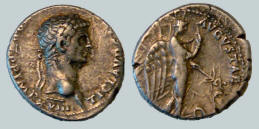 He
ruled the Roman Empire from 41-54 AD between Caligula and Nero, so he had to be
better than either of them. He tried to institute 3 new letters into the
Latin alphabet (below left) but after his death, they died out
He
ruled the Roman Empire from 41-54 AD between Caligula and Nero, so he had to be
better than either of them. He tried to institute 3 new letters into the
Latin alphabet (below left) but after his death, they died out
 and
were no longer used. A stone found in
the 16th-Century displayed a speech by Claudius assuring that the Gauls would
have a greater participation in
Roman politics.
and
were no longer used. A stone found in
the 16th-Century displayed a speech by Claudius assuring that the Gauls would
have a greater participation in
Roman politics.
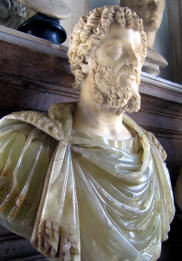
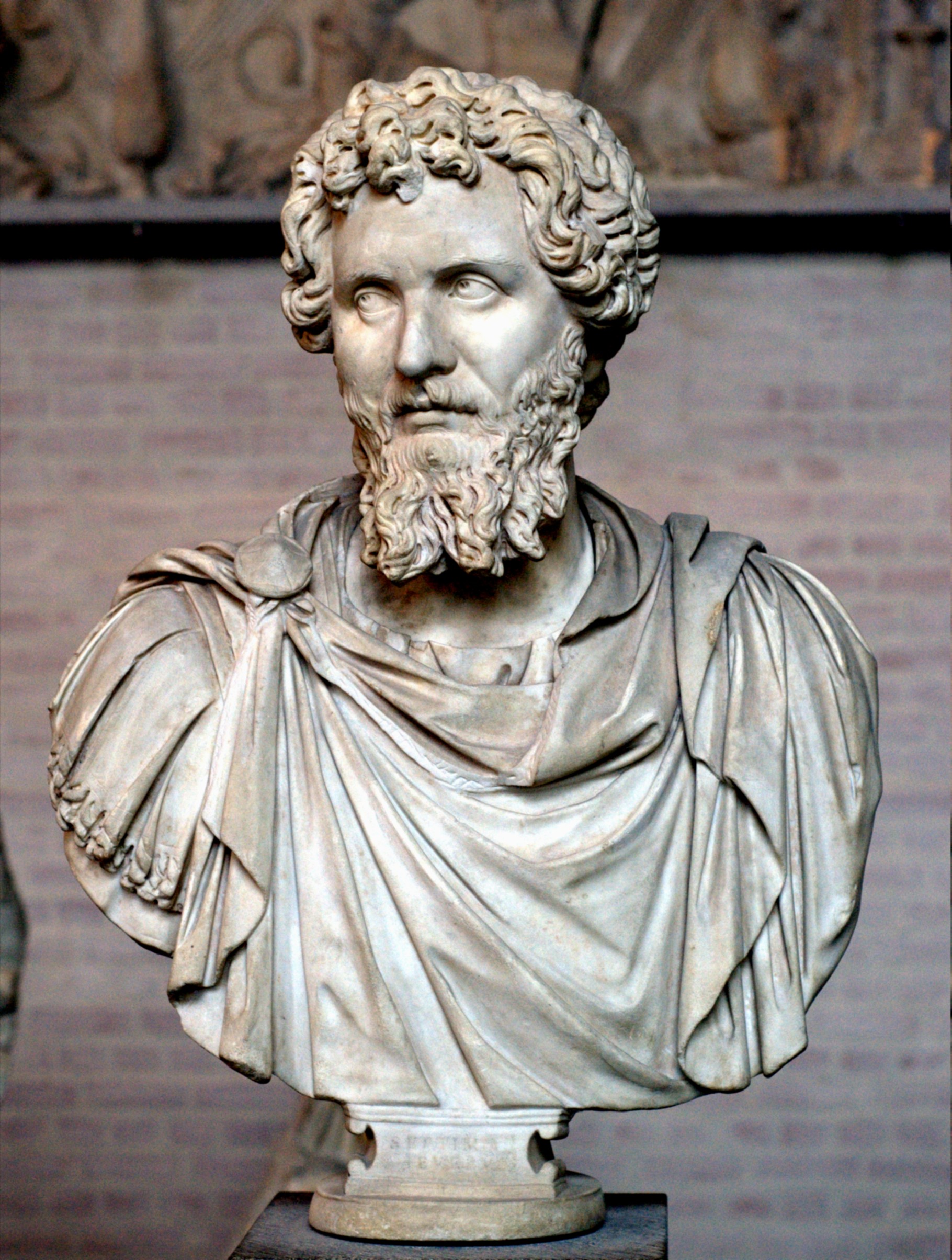
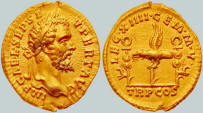 Christianity
arrived in Gaul and the then governor ,
Septimus Severus (left
& right) ruled from 187-188 AD and massacred many Christians. On February
19, 197 AD, in the
Battle of Lugdunum (Lyon,) with an army of 100,000 men, mostly composed of
Illyrian, Moesian and Dacian legions, Severus defeated and killed
Clodius Albinus,
(below
right) securing his full control over the Empire. After Clodius committed
suicide at the end of the battle, Septimus trampled
his body with his horse and
Christianity
arrived in Gaul and the then governor ,
Septimus Severus (left
& right) ruled from 187-188 AD and massacred many Christians. On February
19, 197 AD, in the
Battle of Lugdunum (Lyon,) with an army of 100,000 men, mostly composed of
Illyrian, Moesian and Dacian legions, Severus defeated and killed
Clodius Albinus,
(below
right) securing his full control over the Empire. After Clodius committed
suicide at the end of the battle, Septimus trampled
his body with his horse and
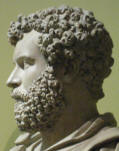 then beheaded him, threw his body into the Rh�ne,
and sent his head to Rome as a warning to the Senate. He thus became the
next Roman Emperor. His statue (above left) is in the
Musei Capitolini in Rome and the
one above right is in the
Glyptothek in Munich as is the statue of
Marcus Aurelius
(left) who
then beheaded him, threw his body into the Rh�ne,
and sent his head to Rome as a warning to the Senate. He thus became the
next Roman Emperor. His statue (above left) is in the
Musei Capitolini in Rome and the
one above right is in the
Glyptothek in Munich as is the statue of
Marcus Aurelius
(left) who
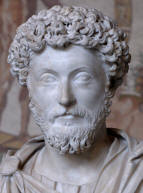 is also claimed to have committed the Christian massacres in Lyon,
though he was otherwise considered the last of the "good" emperors of Rome.
is also claimed to have committed the Christian massacres in Lyon,
though he was otherwise considered the last of the "good" emperors of Rome.
At the end of the 5th Century, Lyon was the capital of the Kingdom of Burgundy, but after 534 AD, it passed to the domination of the kings of France. Ravaged by the Saracens in 725, the city was restored through the generosity of Charlemagne who established in Lyon a rich library in the monastery of Ile Barbe, the first monastery in France. Lyon became officially part of France at the start of the 14th Century. The Italian Florentine Medicis switched from Gen�ve to Lyon, when the former became Protestant.
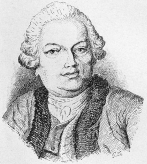 Claude Bourgelat (1712�79)
(right) was a French veterinary surgeon born in Lyon. He was originally a
lawyer but forsook that to discover a cure for a cattle plague. In doing
so, he founded a college for veterinary medicine in Lyon in 1762, which was the
first veterinary school in the world. Along with his students, he
ultimately discovered the cause of the malady and helped cure it. See,
sometimes lawyers can do some good.
Claude Bourgelat (1712�79)
(right) was a French veterinary surgeon born in Lyon. He was originally a
lawyer but forsook that to discover a cure for a cattle plague. In doing
so, he founded a college for veterinary medicine in Lyon in 1762, which was the
first veterinary school in the world. Along with his students, he
ultimately discovered the cause of the malady and helped cure it. See,
sometimes lawyers can do some good.
Claude-Fran�ois-Doroth�e, the Marquis de Jouffroy d'Abbans (1751�1832) is claimed by the French as the first inventor
of the steamboat. His statue (left) is in
Besan�on. His
experimental steam boat (model below) was built in Lyon in 1783. Regular
boat services were not started until 1829 and they continued until 1952.
Jouffroy d'Abbans (1751�1832) is claimed by the French as the first inventor
of the steamboat. His statue (left) is in
Besan�on. His
experimental steam boat (model below) was built in Lyon in 1783. Regular
boat services were not started until 1829 and they continued until 1952.
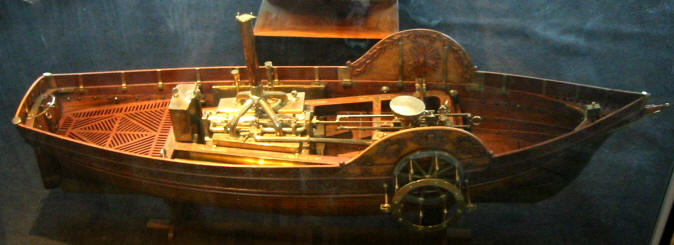
On June 4, 1783, in Annonay
(47 mi south of Lyon) the
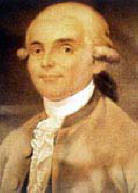
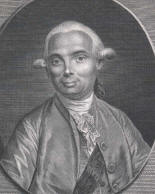 Montgolfier
brothers [Joseph-Michel (1740-1810, left) and Jacques-�tienne (1745-99,
right)] made their first public unmanned hot air balloon flight. The event
is celebrated annually each June, on the site of the flight in the place des
Cordeliers. It was Etienne (which means Stephen) who later made the first
tethered manned flight in this balloon in June of 1783. Below left is a
model of the first Montgolfier balloon and a rendition of the first flight
(below right.)
Montgolfier
brothers [Joseph-Michel (1740-1810, left) and Jacques-�tienne (1745-99,
right)] made their first public unmanned hot air balloon flight. The event
is celebrated annually each June, on the site of the flight in the place des
Cordeliers. It was Etienne (which means Stephen) who later made the first
tethered manned flight in this balloon in June of 1783. Below left is a
model of the first Montgolfier balloon and a rendition of the first flight
(below right.)

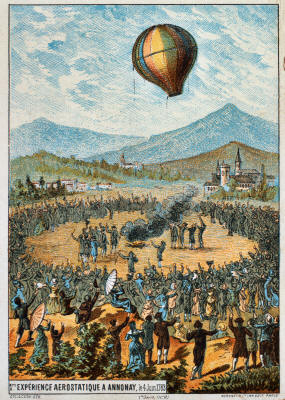
Jean-Fran�ois Pil�tre de Rozier (1754�85) (below left) was a French
chemistry and
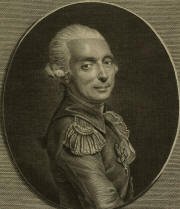 physics
teacher.
physics
teacher.
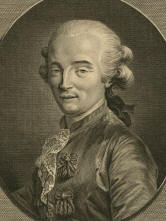 He
and the
Marquis d'Arlandes (right) made the first manned untethered free balloon
flight on November 21, 1783, in a Montgolfier balloon. Two years later,
Rozier died when his balloon crashed near
Wimereux* in the
Pas-de-Calais during an attempt to fly across the English Channel. He and
his companion, Pierre Romain, became the first known fatalities in an air
crash. The
He
and the
Marquis d'Arlandes (right) made the first manned untethered free balloon
flight on November 21, 1783, in a Montgolfier balloon. Two years later,
Rozier died when his balloon crashed near
Wimereux* in the
Pas-de-Calais during an attempt to fly across the English Channel. He and
his companion, Pierre Romain, became the first known fatalities in an air
crash. The
 Rozi�r
balloon was a combination hydrogen and hot air balloon. Below left is a
depiction of the crash and on the right is a rendering of their first manned
flight.
Rozi�r
balloon was a combination hydrogen and hot air balloon. Below left is a
depiction of the crash and on the right is a rendering of their first manned
flight.
* This is where the first radio link between France and England was established
in April 1899 by
Guglielmo Marconi (right) and �douard Branly.
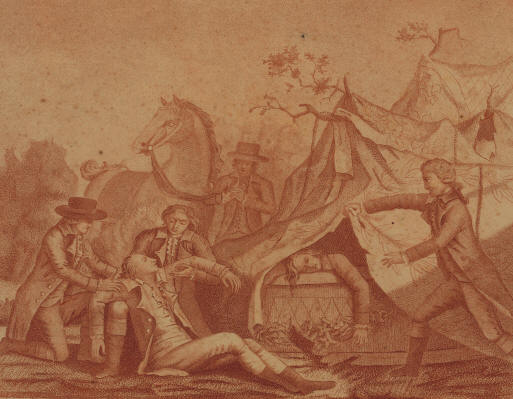
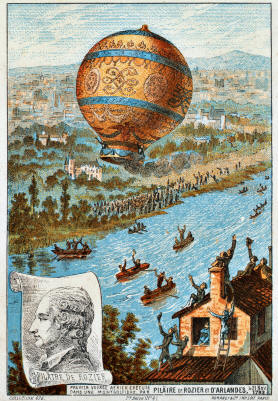
Some claim that
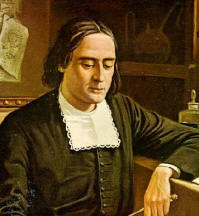 the
hot air
the
hot air
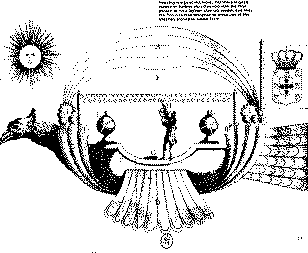 balloon
was invented some 74 years earlier by the Brazilian-Portuguese priest
Bartolomeu de Gusm�o. A description of his invention was published in
1709 (right,) in Vienna, and another one that was lost was found in the Vatican
in 1917. However, this claim is not generally recognized by aviation
historians outside the Portuguese speaking community, especially not by the
French.
balloon
was invented some 74 years earlier by the Brazilian-Portuguese priest
Bartolomeu de Gusm�o. A description of his invention was published in
1709 (right,) in Vienna, and another one that was lost was found in the Vatican
in 1917. However, this claim is not generally recognized by aviation
historians outside the Portuguese speaking community, especially not by the
French.
The population of Lyon mostly hated the French Revolution but it was conquered by the revolutionaries in 1793 and they renamed the city Ville Affranchie (freed town). Obviously that name didn't stick long.
During WWII, the infamous Klaus Barbie
(2 photos left) was in charge of

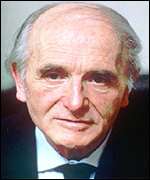 the
the
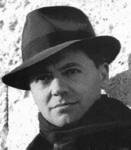 Gestapo
in Lyon between 1942 and 1944 and he captured
and killed the head of the French Resistance,
Jean Moulin (right.)
He was tried here in 1987 (after being found and brought back from Bolivia.)
On July 4, 1987,
Gestapo
in Lyon between 1942 and 1944 and he captured
and killed the head of the French Resistance,
Jean Moulin (right.)
He was tried here in 1987 (after being found and brought back from Bolivia.)
On July 4, 1987,
 Barbie
was sentenced to life
imprisonment
for crimes against humanity, and died
Barbie
was sentenced to life
imprisonment
for crimes against humanity, and died
 in jail in Lyon of leukemia four years
later, at the age of 77. While in Bolivia in the late 1960s, he claims he
helped the CIA murder
Che
Guevara (right.)
in jail in Lyon of leukemia four years
later, at the age of 77. While in Bolivia in the late 1960s, he claims he
helped the CIA murder
Che
Guevara (right.)
Lyon is famous for its "Traboules" which are covered passageways (left) in the buildings. The restored old quarter of Vieux Lyon (Old Lyon) is on the west bank of the Sa�ne River. The wealth of the city is primarily from banking, printing and the silk trade.
Below is a list of interesting places to visit in and around Bellecour:
1) Mus�e des Beaux Arts [20 place des Terreaux,+33-47-210-1740 (closed Tue)],
2) Mus�e de l'Imprimerie (about early printing)[13 rue de la Poulaillerie+33-47-837-6598 (closed Mon-Tue)],
3) Mus�e des Tissus (silk & tapestries) [34 rue de la Charit�+33-47-838-4200 (closed Mon-Tue)],
4) Mus�e des Arts D�coratifs (tap, furniture, porcelain, objets d'art) [30 rue de la Charit�+33-47-838-4200 (closed Mon)],
5) Abbaye St-Martin d'Ainay, a Carolingian church built in 1107 AD.Also click here for a list of all museums in Lyon
I woke at 6:30 AM and at 10:00 and then got up at noon and by 12:30 PM I was having a cappuccino in the hotel lobby and working on Diarios #17and #18. At 2:30 PM I was out the door and on my run, again west toward the Rh�ne river.

I ran through the streets and got to the bridge I crossed yesterday, Pont Bonaparte across the Sa�ne River to reach the Cathedral again.
While crossing the bridge I took a number of pictures of the bridges and the banks of the river.
Below left is the right bank of the Sa�ne River and you can see the church �glise Saint-Georges near the trees (also below right.)

Here is my panorama of the river looking north.
And here is my panorama looking south showing the impressive large
l�H�tel-Dieu (2nd
Arrondissement,
![]() +33-42-008-2069] on the west bank of
the river.
+33-42-008-2069] on the west bank of
the river.
The H�tel-Dieu de Lyon is a functioning hospital of historical significance. First erected in Medieval times, the building originally served as the "Confr�rie des fr�res pontifes" (est. 1184,) a pontifical meeting place and refuge for both traveling and local members of the clergy. Below is a depiction of it from the 1700s.
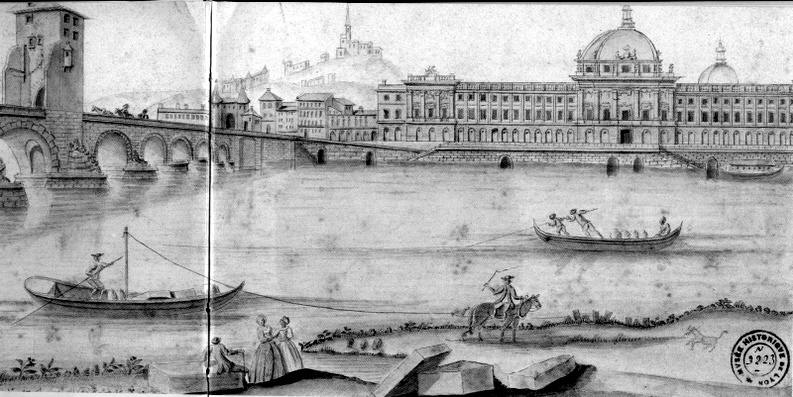
When the first doctor, Ma�tre Martin Conras was hired in 1454, H�tel-Dieu became a fully functional hospital, one of the most important in France. As Lyon was a city known for its trade and seasonal fairs, many of the early patients were weary foreign travelers. Below left is a view of it from the city side.
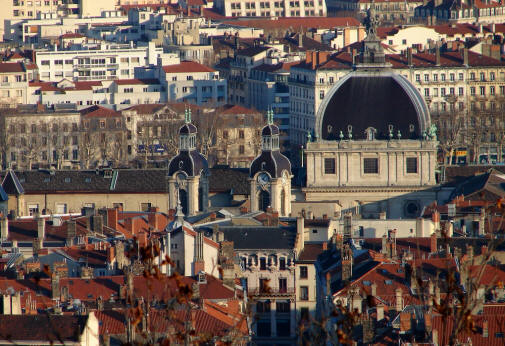
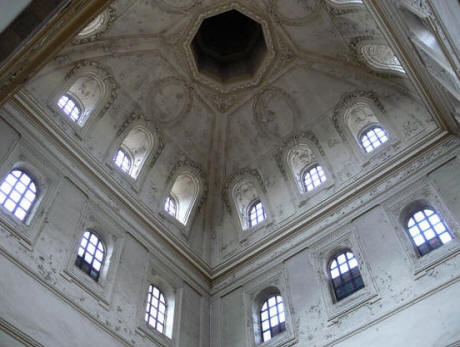
Above right is the inside of the big blue dome you see to the left. Massive expansion projects in the 17th century by Ducellet (under Louis XIII and Richelieu) and in the 18th century by Soufflot (under Louis XIV and Colbert) replaced the original building with the grandiose wings and courts we see today (above left.) In fact, at its greatest extent, the hospital extended from its present position beyond Bellecour to engulf the area now occupied by the central post office.
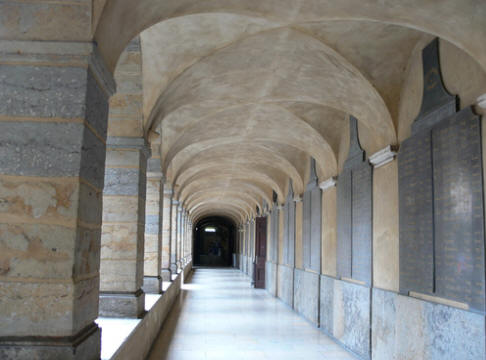
.jpg)
Besides continuing its status as an important hospital for Lyon, it also houses
the "Mus�e des Hospices Civils" [1 Place de l'H�pital,
![]() +33-47-241-3042] a permanent exhibit
tracing the history and practice of medicine from the Middle Ages to modern time
and includes a fine collection of apothecary vases (above.).
+33-47-241-3042] a permanent exhibit
tracing the history and practice of medicine from the Middle Ages to modern time
and includes a fine collection of apothecary vases (above.).
I made it to the other side of the bridge and got another shot of Lyon Cathedral St-Jean. I saw this neat solitary tower with a cross at the top but never found out what it is called.
Here I found this interesting plaque in "Place Charles de Gaulle" (below left) and below right is an example of their electric signs in the streets.
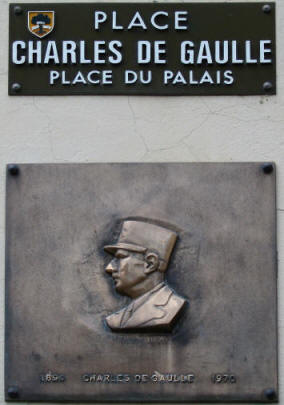
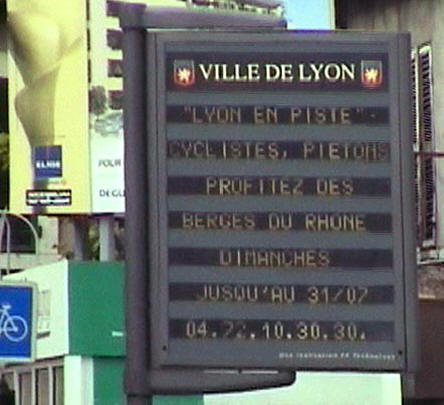
I made my way to Rue de Republic, the fashionable shopping street and...
...arrived in Place de Republic and its huge pool fountain with jets spraying across it intermittently.
Each of the large stone blocks in the pool held a work of art. The theme was labeled "AfricaLyon" with different animals, many of them lions. It was quite an eclectic grouping.
You be the judge as to their artistic merit. As I ran along looking at the shop windows, I got shots of some other kinds of art they have on display.
.jpg)
Somewhere along my run I came across this cascading waterfall and then this curious sculpture on the top corner of this building; very strange.
I came across the Chapelle de l�H�tel-Dieu [Place de l�H�pital,
![]() +33-47-241-3042] (below left.) Below right is the side view of the church.
+33-47-241-3042] (below left.) Below right is the side view of the church.
.jpg)
Above left is a close-up of the very nice statuary above the door of the Chapelle. I kept going and arrived back in Place Bellecour and got a repeat shot of the Louis XIV statue (above right) and shots of the two allegorical statues at his feet. They represent the Rivers Sa�ne (female with lion below left) and Rh�ne (male with lion below right,) created by the brothers Nicolas and Guillaume Costou in 1720.
I was now done with my run and then found the Sofitel Hotel Royal (below right) at one of the corners of Place Bellecour (below left) and at 3:15 I asked the concierge to book our room for tomorrow night at the Dijon Sofitel, our next stop.

Then at 3:45 I had a cappuccino at a caf� in the garden of the plaza and at 4:00 PM Marcia had driven over to pick me up. We met back at the Sofitel Royal and then headed out and at 4:05 we parked the car at the garage under Place des Terreaux (below in center of photo.) It was now time to do some touring together.
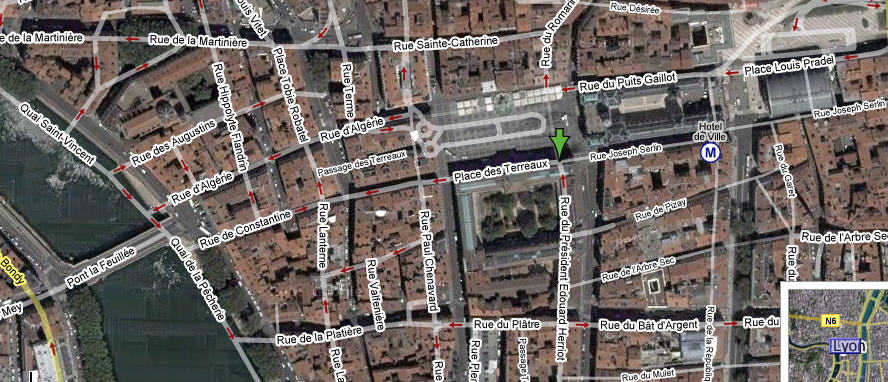
We strolled around like tourists and at 4:15 we found the Mus�e des Beaux Arts Lyon which was a former Benedictine convent called the Palais Saint-Pierre in the 17th Century. This Museum (green arrow in 3 photos below) is the second most important art collection in France after the Louvre in Paris.
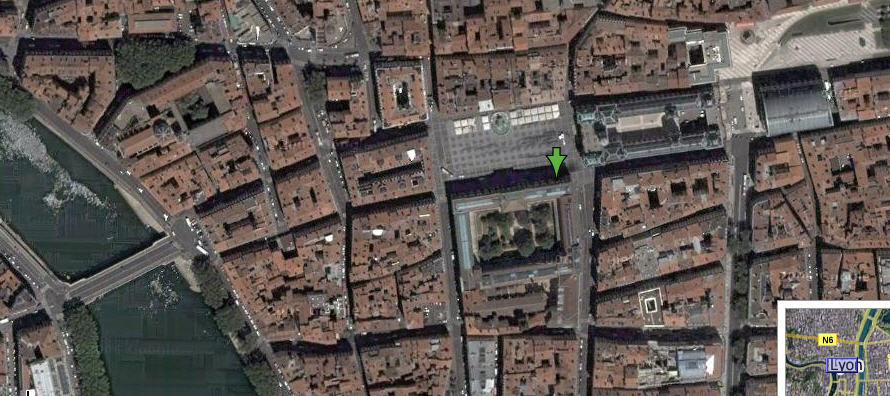
You can see the umbrellas over the tables in the square (below) which look like little white squares.
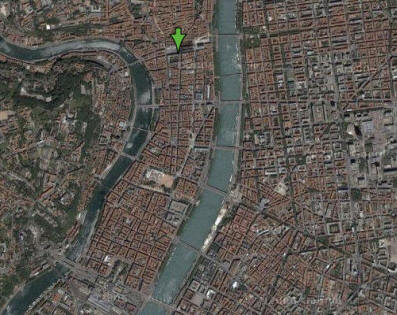
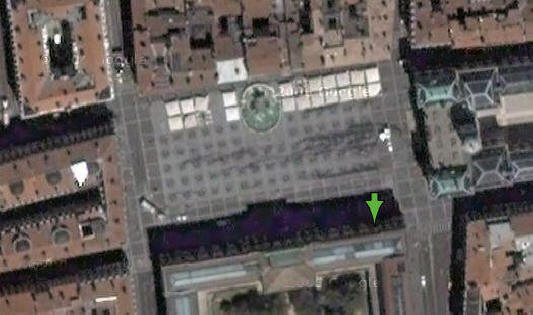
We found the entrance of the Mus�e and paid to go inside.
As can be seen, the Mus�e (Palais Saint-Pierre) is quite a large sprawling building (below.) I'll bet they have a lot of art in there.
Immediately to the left of the Mus�e is the H�tel de Ville, their City Hall (behind white umbrella pole below.) Before going into the museum, I took some shots of it.
As can be seen, the building is quite spectacular (above and below.) Below are stock photos of the dome (left) and a night view (right.)
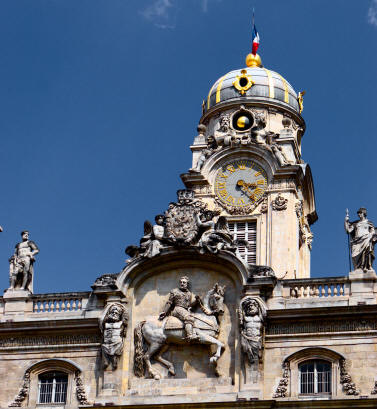
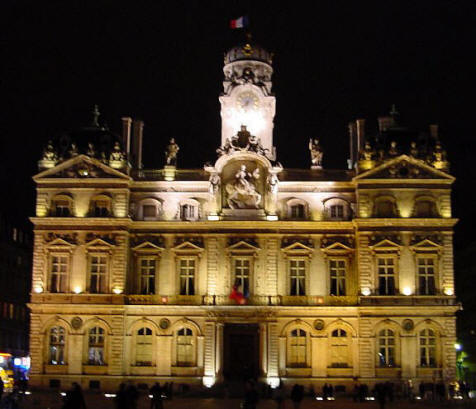
We went inside the museum and was this place big. As usual, they do not allow photography in the gallery so here is just my shot of an example of how the rooms are laid out.
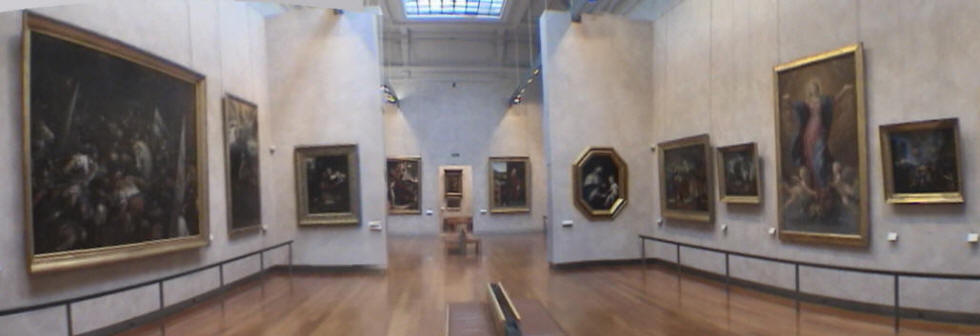
These first photos were taken with the HD video camera and are lower quality than those taken with the Canon still camera. They have been straightened and touched up using Photoshop. For example, below left shows a painting on the wall and on the right is the result of straightening, distorting, cropping and enhancing the same photo to look like it actually did.
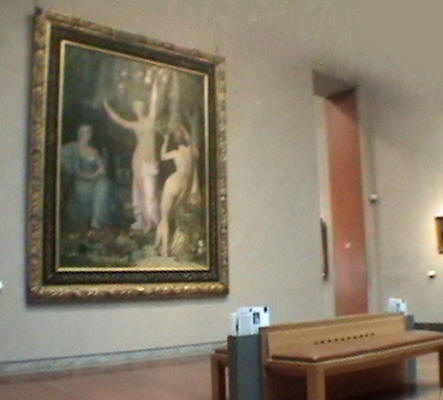
I took a lot of photos so I will just show them all. If you don't like fine art, just scroll down. Here is a Monet (below left) and a whole shelf of busts (below right.)
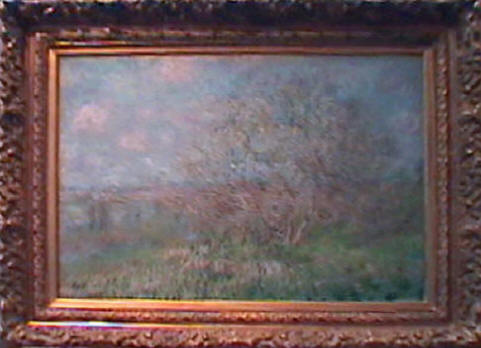
They had room after room of paintings large and small.
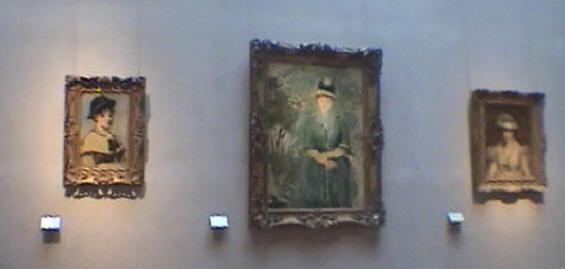
Above right must be an El Greco.
.jpg)
Above right is a Louis Janmot (Lyon 1814�1892) entitled "Rayons de soleil" ("Sun rays." They had a series of large plate medallions. The one below right is of Jean-Paul Marat, the famous physician (who published a textbook on ophthalmology) who was a leader in the bloody French Revolution and was assassinated in his bathtub by a woman.
There collections of ancient coins was extensive; you could spend all day going through them. Here are just some examples of Roman era coins.
Below left is titled "Reves d'Amour" ("Dreams of love") (1833) and on the right is the painting by the guy on the fountain, Hippolyte Flandrin (Lyone 1809{born}/Rome 1864{died}) entitled "Le Dante, conduit par Virgile, offre des consolations aux ames des envieux" (1835.)
.jpg)
Here are three more Masters but I didn't get the artist or the title.
There were many beautiful sculptures from life-size to very small.
Below left is "Portrait d'homme barbu �ge, la main pos�e sur une pi�ce d'armure" ("Portrait of an old bearded man, his hand borne on an armor piece") by Giambattista Tiepolo (Venice 1696/Madrid 1770.) Center is attributed to Lorenzo Tiepolo (Venice 1736/Madrid 1776) called "Portrait of a sculptor" and right is Giuseppe Maria Crespi's (Bologna 1665/1747) "Sainte Madeleine" (1735-40.)
Below left is by Carle van Loo (Nice 1705/Paris 1765) titled "La Messe de Saint Greguire le miracle de l'hostie" ("The Mass of St. Gregory and miracle of the Host) (1764.) It is from the decor of the chapel of St. Gregory in the church of St. Louis Invalides in Paris. On the right is the "La Lapidation de Saint Etienne" (The stoning of St. Stephen) (1625) by Rembrant Harmensz van Rijn (Leyde 1606/Amsterdam 1669.)
Here is another wide-angle shot using PhotoStitch of a typical gallery room.
Below left is a Edgar Degas entitled "Concert at Ambassadors" and on the right is a Auguste Renoir called the "Guitar Player."
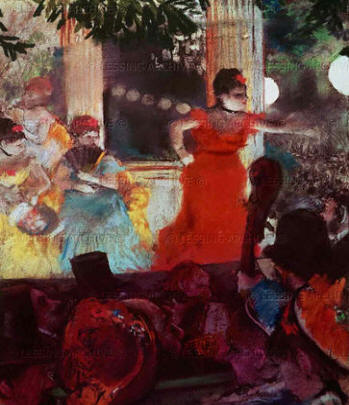
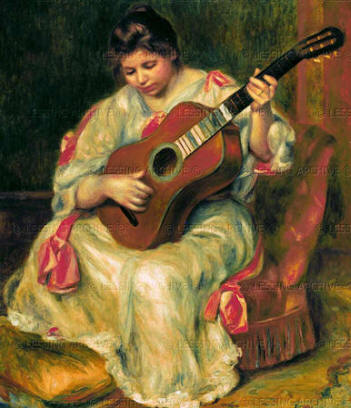
Here is an "aerial" shot out the window from the top floor looking down at the plaza below...
...and a more aerial view of the whole fountain. Of course, that's a Subway shop behind it. This painting (below right) is a little risqu� for the period it was painted.
There were many works of a religious theme such as Nativity and a Last Supper (below.)
Below left is "St. Francis" by Peter Paul Ruebens and center is "L'Incr�dulit� de Saint Thomas" "The doubting of St. Thomas" (1635-7) by Simon Vouet (Paris 1590/1649.) On the right is another "St. Francis" (1659) by the famous Spanish Master, Francisco de Zurbar�n (Pacre de Cantos 1598/Madrid 1664.)
Below left is "Le partage de la tunique du Christ" (L'Espolio) ("The division of Christ's tunic") (1581-6) attributed to Domenicos Theotocopoulos known as El Greco (Candie 1541/Toledo 1614.)
Below left is "La Vierge et l'Enfant avec St-Catherine, St-Augustin, St-Marc et St- Jean-Baptiste" (1549-50) by Tintoreto [Jacopo Robusti] (Venice 1518/1594.) On the right is "La F�te des couronnes de roses" by Albrecht D�rer (Nuremberg 1471/1528.)
On the left (below) is "Nave nave Mahana" (1896) by Paul Gauguin (Paris 1848/Atuana 1903) and on the right is "Pierre Pavis de Chavannes" (1891) (French painter) by Auguste Rodin (Paris 1840/Meudon 1917.)
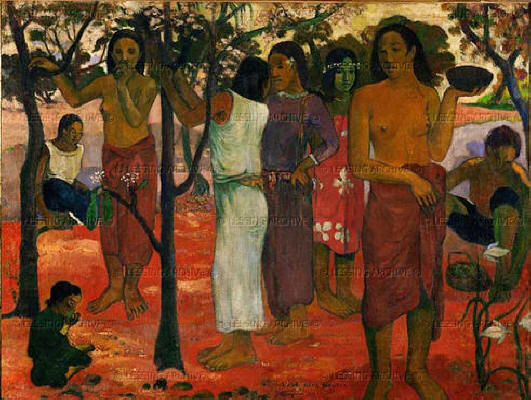
There was a large display of furniture and below is just a few examples.
I just had to photograph this ancient Arabic tapestry. On the right (below) you can see what is going on in the center of the piece (left.) It is of a surgeon performing an eye surgery without anesthesia. It might be a cataract removal but most likely the removal of a ptyerigium.
Below left is a piece from the island of Macao which is called "La vengeance d'H�cube" by a Chinese-Portuguese artist (17th Century) and on the right is a sculpture by Louis Desprez (1799�1870).
Below left is by the famous d'Andre della Robbia (Florence 1435/1525) called "La Vierge et l'Enfant" (1500.) Center is a painting of St-Denis holding his head in his hand and on the right is a French sculpture of Saint Sebastian.
There was a large collection of religious ivory carvings I have seen at several other museums. They are very intricate.
.jpg)
There were many exquisite statues made of various materials and from different eras.
They had a full Egyptian section replete with mummies and well preserved hieroglyphic stone slabs.
We finished up viewing a case full of heads just to give a full sense of the extent of this remarkable museum. It is certainly worth a visit.
We left the museum building and stepped outside into the back gardens which was like a grand park with many people enjoying the ambience and the scenery. In this park were many statues of great artistic significance.
Here are four that I thought were especially important. The first on the left looks like a Rodin might be Hermes. I'm not sure of the others.
I am not sure but I think the first one (below left) is a Rodin and I know the 3rd one is Pan. The two on the right might be Adonis and Venus.
This one (below) looked like the pose of the "Thinker" by Rodin: the inscription on the plaque translated to "Hippocrates arrived in a time that one said not to have reason does or feel in the man and in which beast of siege has the reason, drinks the heart, follows the head." It makes no sense. If anyone speaks French, a better translation would be appreciated.
We exited the museum and Marcia wanted to sit for a minute and survey the plaza. See the large fountain in the distance (below left?) Here it is up close (right.)
.jpg)
This spectacular fountain is by the famous sculptor,
Fr�d�ric
Auguste
.jpg)
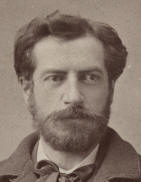 Bartholdi
(left) (1834-1904.) He became famous because he
did the Statue
of Liberty (right.) At the age of 23, he won the contest for a fountain in
Bordeaux, but the city couldn't afford it, so it was bought by Lyon and placed
here. It depicts France as a female seated on a chariot controlling the
four great rivers of France which are represented by wildly rearing and plunging
horses, highly individualized but symmetrically arranged, with bridles and reins
of water weeds.
Bartholdi
(left) (1834-1904.) He became famous because he
did the Statue
of Liberty (right.) At the age of 23, he won the contest for a fountain in
Bordeaux, but the city couldn't afford it, so it was bought by Lyon and placed
here. It depicts France as a female seated on a chariot controlling the
four great rivers of France which are represented by wildly rearing and plunging
horses, highly individualized but symmetrically arranged, with bridles and reins
of water weeds.
[Below are 4 Stock Photos]
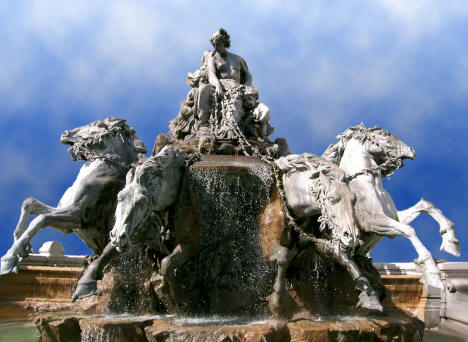
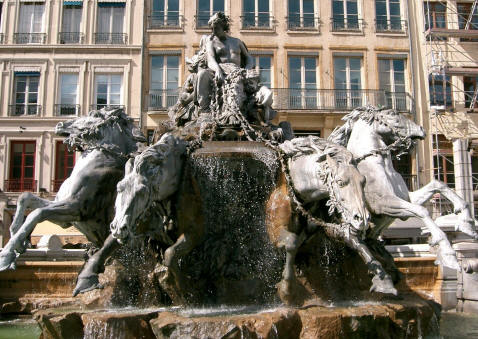
The whole thing weighs 21 tons and is constructed of lead supported by a frame of iron. It was presented at the Exposition Universelle of 1889.
.jpg)
.jpg)
In 1995 it was classified as a monument
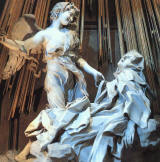
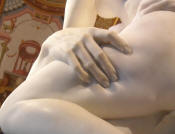
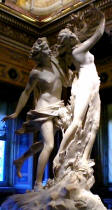 historique
by the French government. Bartholdi seems as epic a sculptor as Bernini
(1598-1680) of Italy, who is my favorite. Bernini's best, in my opinion
are "Apollo and Daphne" (left) and the "Ecstasy of St. Theresa" (right.)
His technique is incredible as shown by the detail in his "Rape of Proserpina"
where her flesh is indented by his fingers (above.)
historique
by the French government. Bartholdi seems as epic a sculptor as Bernini
(1598-1680) of Italy, who is my favorite. Bernini's best, in my opinion
are "Apollo and Daphne" (left) and the "Ecstasy of St. Theresa" (right.)
His technique is incredible as shown by the detail in his "Rape of Proserpina"
where her flesh is indented by his fingers (above.)
I made Marcia pose in front of the fountain. She hates when I do
this but she smiled.
Here are my shots of it from the left side (below left) and from the right side (below right.)
Just off Place Louis Pradel, behind City Hall, is the Op�ra de Lyon or Op�ra Nouvel which
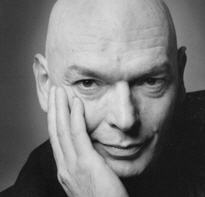 is a black barrel vault of steel
and glass (below) reopened in 1993 to much criticism. It is the home of
the Op�ra National
is a black barrel vault of steel
and glass (below) reopened in 1993 to much criticism. It is the home of
the Op�ra National
 de
Lyon. In 1756, one of the first opera houses created inside an existing
freestanding building was opened in Lyon. It was designed by
Jacques-Germain Soufflot, the architect of the Panth�on in Paris. The
present opera house was re-designed by the distinguished French architect,
Jean Nouvel (above left)
between 1985 and 1993 and is named after him. Below right is another one
of these weird statues in front of the opera house. Jean Nouvel was chosen
as the architect for the new branch of the Louvre being built on Saadiyat Island
in the emirate of Abu Dhabi (model above right.)
de
Lyon. In 1756, one of the first opera houses created inside an existing
freestanding building was opened in Lyon. It was designed by
Jacques-Germain Soufflot, the architect of the Panth�on in Paris. The
present opera house was re-designed by the distinguished French architect,
Jean Nouvel (above left)
between 1985 and 1993 and is named after him. Below right is another one
of these weird statues in front of the opera house. Jean Nouvel was chosen
as the architect for the new branch of the Louvre being built on Saadiyat Island
in the emirate of Abu Dhabi (model above right.)
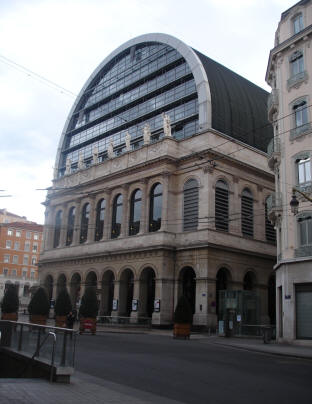
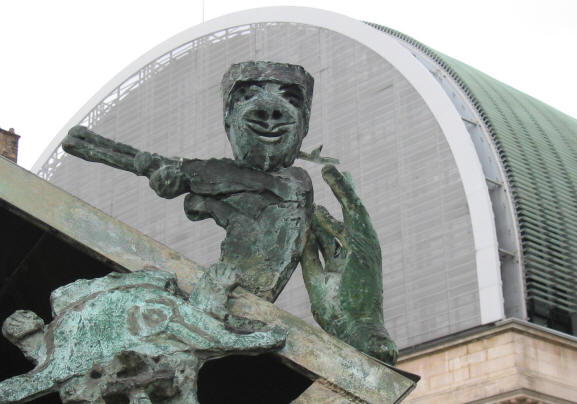
It is expected to be completed by 2013. He is also known for the bullet-shaped and "candy-colored" 38-story 474 ft (144 m) high Torre Agbar in Barcelona finished in 2005 at a cost of $130,000,000.
[ I ran by it on our 2009 trip; it wasn't there the last time we were in Barcelona.]
[Stock Photos below]
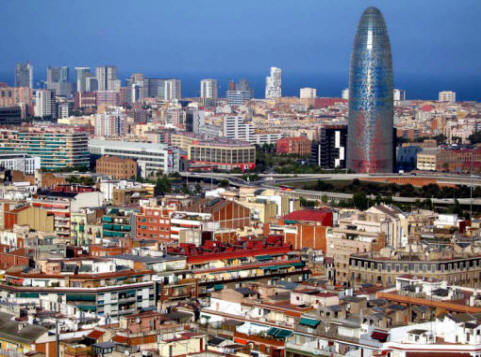
.jpg)
.jpg)
At 6:15 we stopped at the outdoor tables of Le Beverly [8 Place des Terreaux,
![]() +33-97-764-0629] and had a beer and wine. They gave us some free cheese
and olives with our drinks. I had to show you this type of facility that
you come across too often in the EU (below right.)
+33-97-764-0629] and had a beer and wine. They gave us some free cheese
and olives with our drinks. I had to show you this type of facility that
you come across too often in the EU (below right.)
After
relaxing and enjoying the scenery, at 8:00 PM
I
went back down to the garage and changed into street clothes and then we walked to
Rue Merci�re, the famous restaurant row of Lyon we had visited in 1997.
The French word "merci�re" means "merchant." From the 13th to the 18th
Century, it was the main street of Lyon on the left bank of the Sa�ne River and
in the 16th century, it was the street of printers. The southern part of
the street was particularly known for its prostitutes up until the 1970s.
The street was classified as a World Heritage Site by UNESCO. It starts at
Place de Jacobins and runs north/south (below.) The little restaurants
that developed along the street are called "bouchons" and, as you can see, there
are a lot of them to choose from.
I found the one we ate dinner at in 1997, the obviously titled Le Merci�re. We sat down and had a glass of wine for old time's sake.
.jpg) To get there, we had walked by
�glise Saint-Nizier
(above left) which is between the
Place des Terreaux and the
Place des Jacobins. Its name refers to
Nicetius, a bishop of the city during the 6th Century. At 8:15 PM we
had a Corona (can you believe it?) and a wine at The Charles' Inn's Caf� L�one
Bodega [50 rue Merci�re,
To get there, we had walked by
�glise Saint-Nizier
(above left) which is between the
Place des Terreaux and the
Place des Jacobins. Its name refers to
Nicetius, a bishop of the city during the 6th Century. At 8:15 PM we
had a Corona (can you believe it?) and a wine at The Charles' Inn's Caf� L�one
Bodega [50 rue Merci�re,
![]() +33-47-240-0819.] I guess Mexican beer is more popular than Spanish.
+33-47-240-0819.] I guess Mexican beer is more popular than Spanish.
Then we walked some more and at 8:45 PM had a beer and wine at Fa�ade Caf� [45
Rue Merci�re,
![]() +33-47-842-9813.] I had the urge to go for a walk and explore the length
of the street while Marcia sat and
relaxed. When I got to the end of the the street, I wound up in the 2nd
Arrondissement at a famous confluence of 12 streets called
Place des Jacobins.
Below is my Photostitch panorama of it.
+33-47-842-9813.] I had the urge to go for a walk and explore the length
of the street while Marcia sat and
relaxed. When I got to the end of the the street, I wound up in the 2nd
Arrondissement at a famous confluence of 12 streets called
Place des Jacobins.
Below is my Photostitch panorama of it.
.jpg)
Below is an old postcard showing how it looked in 1900.
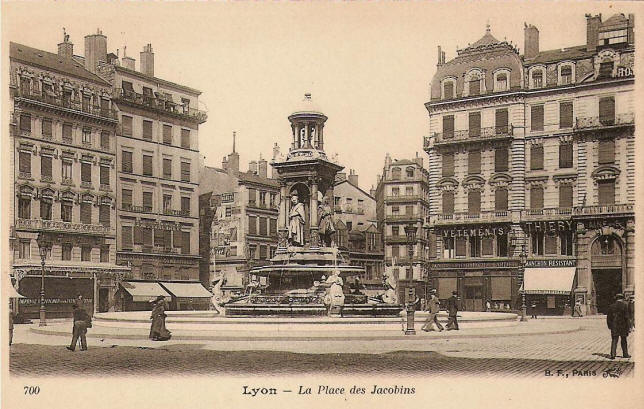
In 100 years the only remaining building is the one on the right (above.) In the
center of the plaza there is a spectacular fountain that was designed
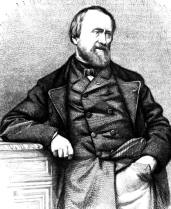 by
Degeorges in 1878. It has four main statues: the statue created in Paris
of
Jean-Hippolyte Flandrin (1809�64) (left) who was a 19th-Century French
painter. His celebrated 1836
by
Degeorges in 1878. It has four main statues: the statue created in Paris
of
Jean-Hippolyte Flandrin (1809�64) (left) who was a 19th-Century French
painter. His celebrated 1836
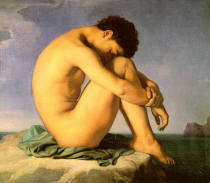 work
"Jeune Homme Nu Assis au Bord de la Mer" ("Young Male Nude Seated beside the
Sea") (right) is in the Louvre. One of his paintings is above. The other 3
statues were carved in Lyon. They are of
G�rard Audran (1640�1703)
work
"Jeune Homme Nu Assis au Bord de la Mer" ("Young Male Nude Seated beside the
Sea") (right) is in the Louvre. One of his paintings is above. The other 3
statues were carved in Lyon. They are of
G�rard Audran (1640�1703)
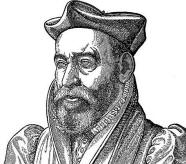 who
was a French engraver,
Guillaume Coustou the Elder (1677-1746) who was a French sculptor employed
by Louis XIV and Louis XV and finally
Philibert de l'Orme (1514-70) (left) who was a French architect and one of
the great masters of the French Renaissance. In 1548, Henry II gave him
the supervision of the construction of Fontainebleau and he built the Ch�teau
Neuf. Under Charles IX, he was employed to construct the famous Tuileries
Palace in Paris, where Marie Antoinette and Louis XVI were captured. It
sat near the Louvre but is no longer there. Below center
are the statues of Coustou (left) and
Flandrin and below right are del'Orme (left) and Audran (right.)
who
was a French engraver,
Guillaume Coustou the Elder (1677-1746) who was a French sculptor employed
by Louis XIV and Louis XV and finally
Philibert de l'Orme (1514-70) (left) who was a French architect and one of
the great masters of the French Renaissance. In 1548, Henry II gave him
the supervision of the construction of Fontainebleau and he built the Ch�teau
Neuf. Under Charles IX, he was employed to construct the famous Tuileries
Palace in Paris, where Marie Antoinette and Louis XVI were captured. It
sat near the Louvre but is no longer there. Below center
are the statues of Coustou (left) and
Flandrin and below right are del'Orme (left) and Audran (right.)
Below left is a frontal view of Flandrin and the nymphs at the base appear to be having a great time.
As I walked back to get Marcia I came across this excellent caryatid display on one of the buildings.
I picked up Marcia and we left and after exploring all the many possibilities,
finally decided at 9:15 to have dinner at the La Traboulerie [58 Rue
Merci�re,
![]() +33-47-277-5202] and picked an outdoor table. Marcia is in the front in a
white blouse. It certainly was a lovely evening.
+33-47-277-5202] and picked an outdoor table. Marcia is in the front in a
white blouse. It certainly was a lovely evening.
We looked over their carte des vin (wine list, below center) and selected a bottle of 2003 Domaine des Brillats Beaujolais Villages and a � bottle of Badoit sparkling water.
We looked over the menu for this "bouchon lyonnais."
I based my choices on the recommendations of the cab driver that drove us down the mountain in Grenoble. To start I had their special Lyonnais onion soup (gratine lyonnaise) (below left) followed by an entree of lyonnaise chicken with potatoes and rice (below right.)
Marcia began with her favorite, Chevre cheese salad (below left) and then her entree was a mixed meat grill with potatoes (below right) that...
...she cooked herself on a very hot stone placed at our table (below.) It was kind'a fun watching the meat gently sizzle on the stone.
For dessert I had their crepe frambois (raspberry) with vanilla gelato.
At 9:45 it started to downpour, so we had to move inside. We relaxed and enjoyed watching the rain and when it finally stopped at 11:15 PM, we walked back to Place de Terreaux, got the car and at 11:30 drove back to the hotel. At 11:45, I had a cafe au lait while working on Diarios #19 and #20. I got to bed at 2 AM.
Kenneth J. Hoffer, MD
Lyon, France
Sent 7-6-10
If you enjoyed these travels or wish to add comments on the places we visited
Please Leave Me a Message by clicking the spinning @ sign below.

